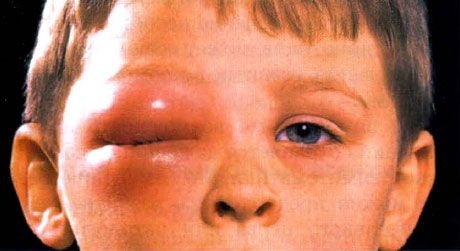Medical expert of the article
New publications
Extraorbital cellulitis in children
Last reviewed: 05.07.2025

All iLive content is medically reviewed or fact checked to ensure as much factual accuracy as possible.
We have strict sourcing guidelines and only link to reputable media sites, academic research institutions and, whenever possible, medically peer reviewed studies. Note that the numbers in parentheses ([1], [2], etc.) are clickable links to these studies.
If you feel that any of our content is inaccurate, out-of-date, or otherwise questionable, please select it and press Ctrl + Enter.
Extraorbital cellulitis is characterized by the localization of the inflammatory process in front of the tarso-orbital fascia, which prevents the spread of infection into the orbit.

Cause of extraorbital cellulitis in children
- Inflammatory diseases of the eyelids (eg, herpes simplex), acute blepharitis, infected chalazion, impetigo, skin abscesses.
- Dacryocystitis.
- Trauma accompanied by purulent cellulitis caused by Staph. aureus and Streptococcus.
- Upper respiratory tract infections of streptococcal origin and influenza with hemorrhagic syndrome (especially typical for young children).
Symptoms of extraorbital cellulitis in children
The disease usually manifests itself as unilateral swelling of the eyelids, fever, and leukocytosis. Local pathology is often detected: chalazion, dacryocystitis, etc. Lacrimation and discharge from the conjunctival cavity may be present.
Where does it hurt?
What do need to examine?
How to examine?
Treatment of extraorbital cellulitis in children
In most cases, treatment is carried out in a hospital, after consultation with a pediatrician and/or infectious disease specialist.
Antibacterial therapy
When the pathogen is stained according to Gram, specific therapy is prescribed that corresponds to the identified sensitivity. It is not recommended to start treatment before receiving the results of laboratory tests, including blood tests.
In cases where the disease is a consequence of trauma, the use of oxacillin or nafcillin in a daily dose of 150-200 mg/kg of weight is indicated. If an upper respiratory tract infection occurs, cefuroxime is prescribed in a daily dose of 100-150 mg/kg of weight or a combination of ampicillin in a daily dose of 50-100 mg/kg of weight and chloramphenicol in a daily dose of 75-100 mg/kg of weight. In some countries, chloramphenicol is not approved for use due to the possibility of side effects. In any case, treatment begins with intravenous administration of the selected drug. After receiving the results of the study of scrapings from the affected tissues and bacteriological blood tests, as well as in the absence of a full effect from the therapy, the antibiotic used can be changed.
The need for abscess drainage is rare. Surgical intervention is indicated only in cases where there is no positive dynamics after several days of intensive antibiotic treatment.


 [
[